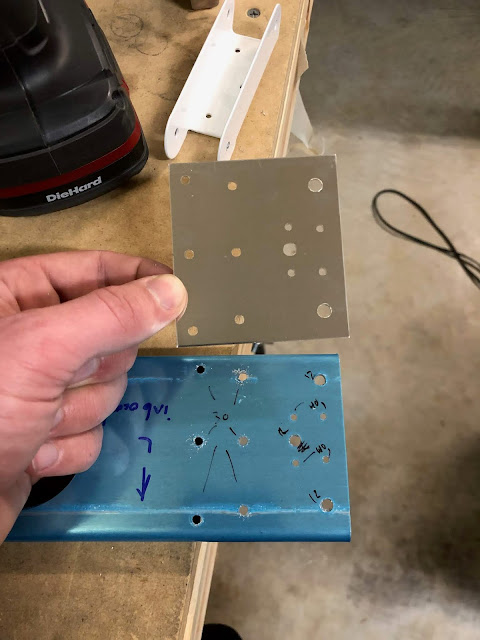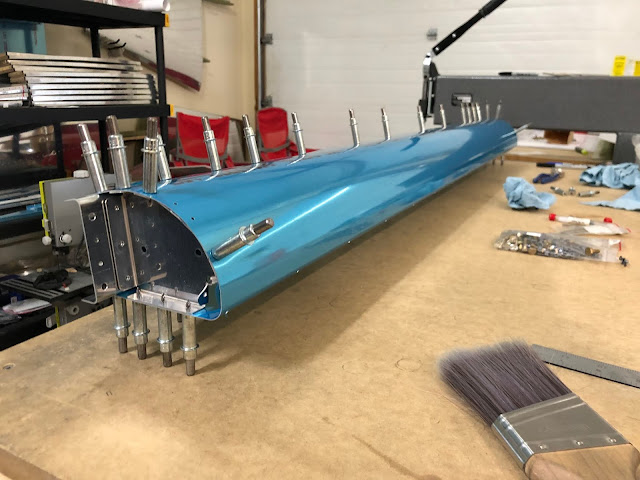To start, the ribs need to be clecoed to the spars and to the lower flap skin to be match drilled. What's interesting here is that all of the internal FL-705 ribs face left on both the left and right flaps while the inboard and outboard ribs are oriented so that the webs face the inboard side.
 |
| It looks weird, but it's correct according to the plans. |
Since the top skin will overlap the bottom skin on the bottom side of the flaps, there will be a gap between the top skin and the very ends of the inboard/outboard ribs. The plans say to make some shims from a .025 thick sheet of aluminum (the same thickness as the ribs), but I was hesitant to cut into the one sheet that was included in the wing kit since I didn't know what else I would need to use it for.
As it turns out, the practice kit I had worked on months ago that I was currently using as scrap had a perfectly good sheet of .025 aluminum on it, so I cut some off to use for the four shims I needed to make.
After cutting them to size and rounding off the corners I had some perfectly good shims made from aluminum I'd otherwise never have used.
 |
| I'll have to match drill these to the inboard and outboard ribs later. |
There were a couple of holes the need to be match drilled through the skin and into the ribs. The holes along the rear "spar" formed in the skin weren't difficult to drill, but there were some spaces between the ribs and the spar that will need to be corrected with some more shims.
 |
| No shims were needed on the first and fourth ribs since they were already sitting flush... |
 |
| ...but the middle ribs will need a shim here to keep the whole flap from warping when this area is riveted. |
The shims needed here didn't have to be as thick as the previous shims, so I cannibalized one of the thinner skins from the practice kit for the material I needed.
 |
| These are probably the tiniest parts I've had to fabricate thus far. |
 |
| Holes drilled... |
 |
| ...and in place. Perfect! |
Before putting on the top skins, I worked on the hinges that will attach the flaps to the wings and allow them to move up and down. The hinges come way too long and have no holes in them, so they need to be trimmed to length and match drilled with the skin/spar.
It's been said before, but the empennage really is the training ground for what you'll encounter later on in the build. The process to finish these hinges was exactly the same as it was for the trim tab assembly. I started by drawing a line at 1/4" all the way down the spar to help align the hinge with the flap. Thankfully there is enough space on the larger flaps to clamp the entire hinge in place. What's interesting is that having the holes aligned with this line causes the hinge to be flush with the enge of the skin/spar.
 |
| Perfectly aligned. |
With the hinge meticulously clamped in place, I started at one end and carefully worked my way down. I had a system of putting in multiple clamps ahead of the next few holes so I would only have to remove a clamp instead of moving it one space over every time I move to a new hole. Eventually I had the entire hinge clecoed in place.
After trimming it to the right length I reinserted the hinge pin to get a feel for how it will look when it's ready to install on the wing.
On went the top skin so it could be drilled to the skeleton. The plans specifically state to align and drill the ribs on the top of the flap before drilling the lower "spar" where the top skin connects to the bottom skin. Since there's a lot of spring in the bend of the top skin this is probably to prevent drilling the parts with a twist. I left the bottom spar unclecoed while I drilled the top ribs and main spar, then clecoed the rear spar and drilled it.
Even without a level I can tell that there's pretty much no twist in these parts at all after drilling, so it looks like I did a good job!















































